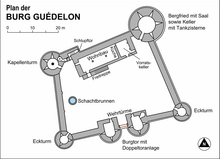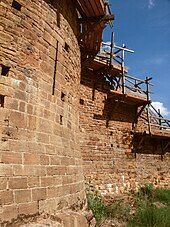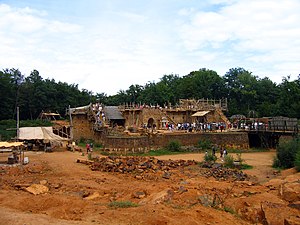Guédelon
Guédelon is a castle building project in the French commune of Treigny in the Yonne department . According to the principles of experimental archeology , only techniques from the 13th century are used in this reconstruction project ; construction began in 1997. Completion of the castle is planned for 2023.
location
Guédelon is located in the municipality of Treigny in the Burgundy region , 150 kilometers as the crow flies and around 200 kilometers by road south-southeast of central Paris , and 40 kilometers southwest of the city of Auxerre near the town of Saint-Sauveur-en-Puisaye . The French autoroute A 77 runs around 30 kilometers to the west, which accompanies the Loire River on this last section .
Building history
Origin of the project
Michel Guyot , the founder of the project, had gained experience in the restoration of palaces and castles in the region since the 1970s. With the Guédelon Castle he is realizing a long-cherished dream. After a long search for a suitable place where sufficient building materials such as stone, wood and water would be available, construction began in 1997 in a disused quarry . Only methods from the 13th century were used wherever possible, such as B. the twelve-knot cord for determining right angles.
Architectural model
The architectural model is provided by the architectural canons of the 12th and 13th centuries that were valid at the time of Philip II , the French king from 1180 to 1223, with the standard of fortress architecture ordered by the king. The castles Louvre in Paris, Yèvre-le-Châtel in the Loiret as well as the nearby Ratilly Castle and the castle ruins in Druyes-les-Belles-Fontaines are examples of this.
The castles according to Philippian architecture (French: architecture philippienne ) have the following characteristics:
- a rectangular floor plan
- high shield walls , the lowest areas of which are often bevelled and stand in a dry ditch
- the castle gate with the two defense towers
- cylindrical corner towers with simple, alternating loopholes on different levels
- a chapel tower and a higher and more powerful main tower, the keep
- in between the so-called Châtelet, a small quarter for soldiers, named after the Latin term castrum
- a shaft well in the courtyard
Philip II, with whom the hereditary monarchy began in France after the electoral monarchy was replaced , had begun a permanent Capetian expansion policy with clever alliance and marriage contracts , which justified the adoption of a French instead of a Burgundian architectural model in this part of the Yonne.
Construction progress
After construction began in 1997, scientists from a wide variety of fields began to take an interest in the project. The project received specialist advice and support from cultural , building and art historians , architects and archaeologists . It turned out that many medieval building techniques had to be redeveloped.
The project is carried out under the most authentic conditions possible, similar to the principles of experimental archeology. Therefore, the craftsmen and employees wear medieval garments, apart from personal protective equipment such as B. Safety glasses and steel toe shoes. All tools and aids such as cranes , falsework and vault formwork are manufactured on site. Transports are carried out with large-wheeled horse carts .
In the meantime, a settlement of suppliers has arisen around the construction site, in which craftsmen produce roofing shingles, baskets, pottery, tiles, nails, tools, ropes, beams, wool and clothing, among other things; horses, sheep, pigs, geese, chickens and ducks are also kept.
Wood for the scaffolding is felled in the surrounding forest, quarry stones are broken in the old quarry in which the construction site is located with simple, time-typical tools and transported to the stonemason's workshops by horse and cart . Neither cement nor screws are used; instead, mortar is made from sand, clay and slaked lime on the construction site . The only exception are the scaffolding, which for safety reasons is made of wood processed using modern methods and connected with metal screws.
Nails are hand forged in the local blacksmith's shop. However, some raw materials are delivered, for example pig iron of rather poor quality (no steel) or the said slaked lime, as its production on site would be too dangerous. Mortar and stones are then brought to their destination in hand-made baskets.
Under the direction of Michel Guyot, 50 full-time workers and in the high season up to 16 volunteers are expected to work at the castle until 2023 . The work is suspended from November to March each year. During this time the construction site is also closed to visitors.
- Construction progress since 2000
Subsidiary project in the USA
Under the name Ozark Medieval Fortress , a subsidiary project was started in the US state of Arkansas in 2008 , also under the direction of Michel Guyot. It was closed in 2012 until further notice.
Economic data
Tourist importance
According to the operator, the plant already had around 65,000 visitors in the second year, compared to 245,000 in 2005. In the 2010 season, 320,000 people visited the castle field of Guédelon, of which around 80,000 were students. There were the same number in 2011. With 297,856 visitors in 2014 and 304,189 in 2015, the numbers were slightly below those of previous years. Nevertheless, the castle construction site was the most visited attraction in the Yonne department in 2015 after the basilica Sainte-Marie-Madeleine in Vézelay .
financing
Initially, the project was dismissed as dubious. When the seriousness and increasing construction progress began to emerge, the French state and the European Union sponsored Guédelon with 2.5 million euros. Since the end of this funding, the major project has been self-supporting through donations, entrance fees, merchandising and catering.
Movies
The documentary filmmaker Reinhard Kungel has been accompanying the construction work with his film team since 2000. In addition to documentaries about Guédelon for Arte and WDR / SWR , the team produced a trilingual DVD. On September 13, 2016, Arte broadcast the ninety-minute documentary Guédelon: We're building a castle from 2014. In 2019, a second 91-minute part of the documentary entitled Die Burg-Baustelle was broadcast. Both documentations are available on the Arte channel on YouTube.
See also: Bianca Zamfira: Guédelon - The castle construction site
See also
- Campus Galli , the project Carolingian monastery town Meßkirch
- Experience castle building Friesach , castle building project in Friesach in Carinthia
- Duncarron , a replica of a fortified medieval village in Scotland near Stirling
literature
- Thomas Bitterli-Waldvogel: Guédelon. Building a castle in the 21st century. Experimental archeology and tourist magnet. In: Castles and Palaces . Vol. 47, No. 4, 2006, ISSN 0007-6201 , pp. 198-207 ( digitized version ).
- Werner Bloch: Building a castle without a hardware store and concrete. In: Süddeutsche Zeitung , online edition from 23 August 2011.
- Frank G. Gerigk : Time travel to the year 1263 - In Burgundy the knight's castle Guédelon is being built using construction methods from the Middle Ages. In: Deutsches Baublatt No. 313, June 2005, p. 32 (PDF file; 213 kB).
- Frank G. Gerigk: A crazy Gaul's dream come true - Guédelon: the world's largest, most successful and longest construction project for experimental archeology. In: Momentum Magazine , August 27, 2012.
- Philippe Minard, François Folcher: Guédelon: Des hommes fous, un château fort . Aubanel, Paris 2003, ISBN 9782700603132 .
- Veruschka-Meike Jähnert: The Guédelon castle building project: Acquisition and transfer of knowledge in experimental archeology accessible to the public. Hamburg, 2015, ISBN 9783959347860 .
Web links
- Official website of the project (French, English, German and Dutch)
- Stefan Kälberer: Guédelon - castle building in Burgundy ; Report from June 2007 ( Memento from June 7, 2013 in the Internet Archive )
- Travel back in time to the Middle Ages - a castle is being built in Burgundy. (PDF file; 51 kB) Report by Hans-Peter Frick in SWR2 Wissen, first broadcast on June 5, 2009.
- Main topic: The lost knowledge of medieval builders. Deutschlandfunk from October 17, 2013.
- Guedelon Castle - a construction site like in the Middle Ages. Documentary about the Guedelon construction site on Youtube.
- The construction site of Guédelon Castle as a 3D model in SketchUp's 3D warehouse
Individual evidence
- ↑ Guédelon a castle is built. In: History and Reenactment . December 11, 2009, accessed January 5, 2019 .
- ↑ Michel Guyot, the inventor on ozarkmedievalfortress.com ( Memento of October 27, 2012 in the Internet Archive )
- ^ Ozark Medieval Fortress closed this year. Accessed March 29, 2016.
- ↑ a b Rüdiger Hillenbrand, Marianne Hillenbrand: "Maybe just luck" . In: Südkurier , issue of September 8, 2011.
- ↑ Press information about the project (French) ( Memento from May 12, 2012 in the Internet Archive )
- ^ A b Agence de Developpement Touristique de l'Yonne in Bourgogne: Les site et monuments de l'Yonne. Self-published, Auxerre 2016, p. 2 (PDF file; 772 kB).
- ↑ Ulrich Traub: New, ancient knight's castle. In: Salzburger Nachrichten , edition of April 5, 2003.
- ↑ We'll build a castle | Documentation | ARTE https://www.youtube.com/watch?v=8KE61Wvj2os
- ↑ The castle construction site | Documentation | ARTE https://www.youtube.com/watch?v=ccxbGA0Vy_Q
Coordinates: 47 ° 35 ′ 0 ″ N , 3 ° 9 ′ 21 ″ E

















